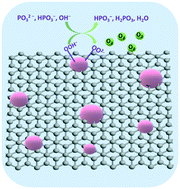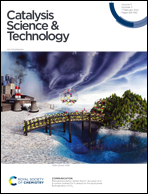Phosphate-assisted efficient oxygen evolution over finely dispersed cobalt particles supported on graphene†
Abstract
Electrochemical water splitting is a process to store renewable energy in hydrogen, which is a green energy carrier producing only water when combusted. However, the overall electrochemical water splitting is limited by the low efficiency of the anodic oxygen evolution reaction (OER) leading to a high overpotential. In this study, finely dispersed cobalt particles supported on graphene are prepared as an anodic catalyst and coupled with phosphate activation to enhance and stabilize OER activity. The small particles enable a high exposure of the surface active sites. Also, the highly conductive graphene backbone accelerates electron transport. Activation by phosphate in the electrolyte leads to the formation of the active Co(III) species with enriched oxygen vacancies meanwhile facilitating the kinetics. The finely dispersed cobalt particles supported on graphene together with phosphate activation lead to high electrochemical surface area and intrinsic activity, achieving a current density of 10 mA cm−2 at an overpotential of 0.35 V and a low Tafel slope of 45 mV per decade, together with good stability. The cobalt mass based current density is 19–8000 times higher than current benchmarking catalysts.



 Please wait while we load your content...
Please wait while we load your content...